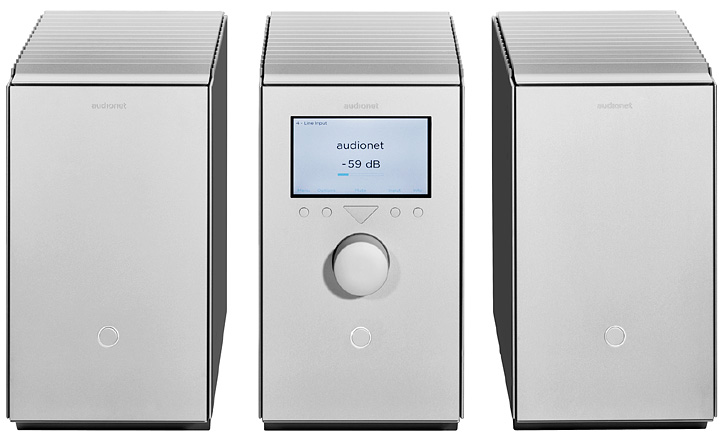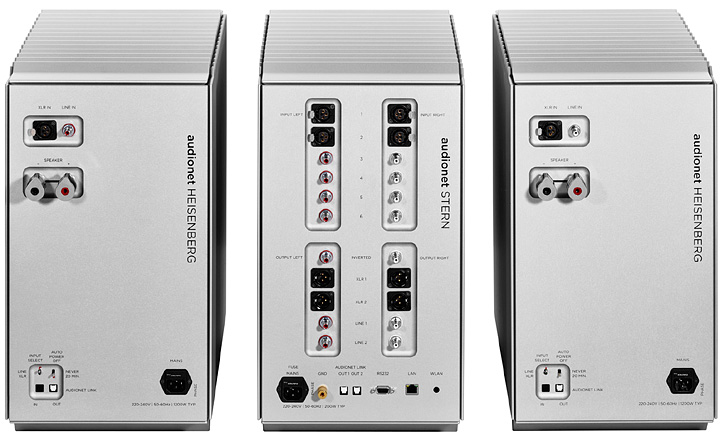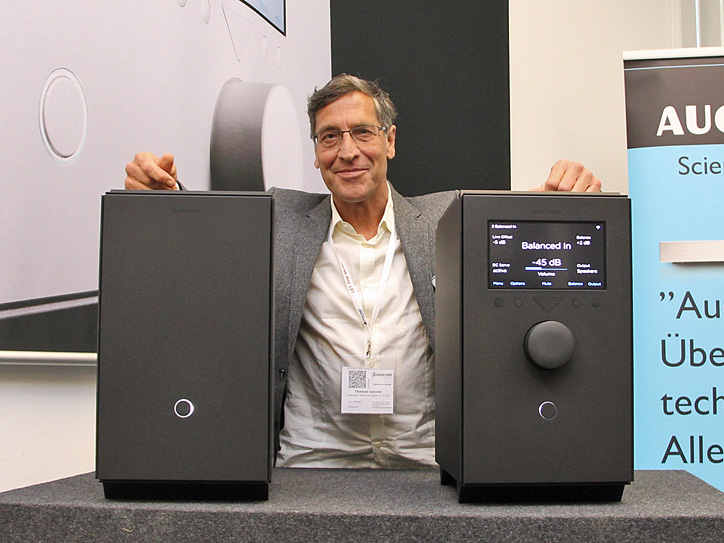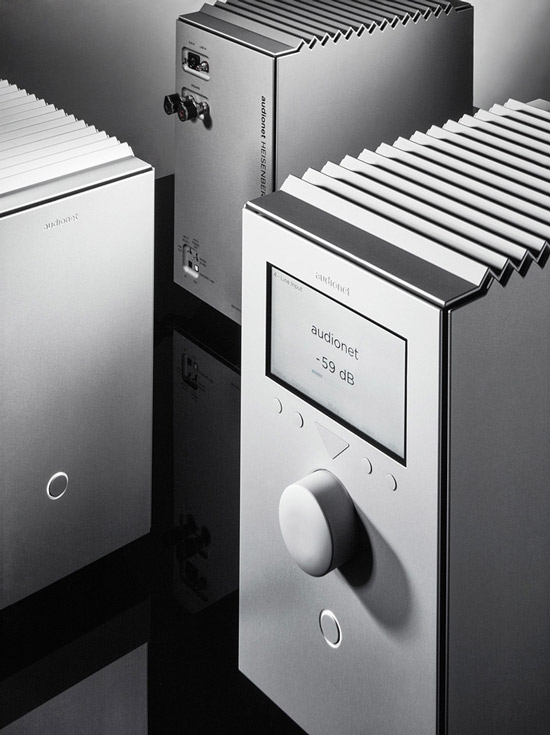
When I was doing my round tour at the High End in Munich this year, I just had to shake my head time and again at how loosely the slogan »experience fair« can be interpreted. What could be heard there offered anything from an acoustical horror trip to cultivated boredom to music systems, which can make you forget everything, absolutely everything around you. The latter occurred to me at the Audionet showroom, where the sounds from Stern and Heisenberg produced a downright magnetic, captivating effect, although the listening volume was on a normal, pleasant level. If music, which actually doesn’t fit into my repertoire, succeeds in grasping my concentration, I know that, in the most positive sense, something’s wrong here.
Seven weeks later, we’re in July and Germany is on summer vacation, spending a large part of the day outdoors. But not me, for I’m sitting in the darkened listening room in front of my sound system. However, it offers quite a different sight as it normally does, because flanked by the Heisenberg mono blocks, the Stern forms the centre, and due to their impressive size the three of them block my view a lot. Yet before listening to these amplifiers, they’re worth taking a look at. After all, they were styled by Hartmut Esslinger, founder of the internationally renowned company named »Frog Design«. This man has achieved everything, which is why he could actually enjoy both his retirement and prosperity. But obviously creativity does never retire.
At first glance one beholds a colossal trio where the mains switches, backlit in white, and the preamp’s large display are initially dominant. But after a while you will slowly become aware of the intelligent combination of squares, triangles and round elements. Moreover, the visual impression changes depending from which direction you look at them. Only then you will see that the enclosure is not made from a single piece, but consists of individual plates whose edges, however, don’t touch each other. That way any tendency towards clumsiness is already successfully countered visually in those hulks – in the past the attribute »too heavy to walk« had stuck to some mighty power amps. But the longer my eyes rest upon Stern and the Heisenbergs, the more I grasp their well-conceived styling.


»When the form is right, we don’t need to deal with the content any more«, is certainly a motto which can often be found also and especially in the audio sector. Yet for more than 20 years Audionet has represented the exact opposite. Endowed with diligence, meticulousness and until today a great deal of idealism, the engineers work at the Berlin based company. The »Nobel Prize Project« is lead by Thomas Pohl and Volker Wischniowski. Using the company’s already excellent amplifier technology as a basis, their task was to not only step up the game, but to realise simply everything it takes for the music experience at the end of the chain.
Any monetary limitations for the components’ acquisition had been swept aside. Standard parts were compared to custom solutions from other branches, which at times produced stunning effects on the sound quality. But the fact that Stern and Heisenberg are no adhoc products which happened to be created in two years’ time, can be deducted from a statement by Volker Wischniowski that refers to the circuitry: Since his study days he had been musing about one or two ideas for an ultimate amplifier concept, which he was now able to realise. The result had rarely been something »just properly functioning«, as he told me; either it convinced by the expected quality – or it turned out to be a flop. »With all of these development structures we learned quite a lot, and of course this know-how will now benefit all Audionet components«, he thus finished his explanations.
A Stern on the Horizon
I can’t remember if I’ve ever had the option of specifying the shape of an audio component – in this case the preamp – during the order process. How would you like to get it: flat or vertical? For me it was pretty clear that, because of the overall visual harmony, only a vertical Stern would come into question. But already among the editorial team there were different views as well, for man is naturally a creature of habit. I’m eager to see whether the versions will balance each other or if there’s a winner. The Stern is the system’s command centre that offers and controls six line-level inputs, two of which with a balanced layout. During the listening checks the designers decided to opt for Furutech rhodium sockets. The pre out signal to the power amps can be flexibly tapped either via RCA or twice via XLR.
The usual standard includes an IEC socket, ground clamp, the Audionet-Link communication interface and the RS232 port. A remarkable feature is the connector for the WLAN antenna, supposed to give the Stern access to e. g. software updates – considering its weight of almost 50 kilos [110 lbs.], this is indeed a very convenient thing. In everyday use its control and operation is a delight. The menu is clearly structured and perfectly readable on the large display. Of course, the volume may also be adjusted via the remote control, but I put it aside instantly because of the big, massive rotary knob which you’d rather expect to find on a bank safe. It is equipped with a double ball bearing and controls a network of painstakingly calibrated precision resistors.



Targetting ultra low crosstalk values, the Stern has been designed with a dual mono layout. The power supply technology has always been a stronghold of Audionet’s. The positive and negative half cycles of the signal are each tapped by a 50 VA transformer. This quartet feeds the current to a phalanx of electrolytic caps which offers an overall sieve capacitance of no less than 176,000 microfarads. Energy aplenty is the credo, and there will hardly ever be a case where this »reservoir lake« won’t deliver an adequate supply. And they also went to great lengths with the resonance optimisation. Numerous parts are soothed by vibration damping measures and isolated via photocouplers to avoid ground problems. A look at the technical specs measured by our i-fidelity.net lab reveals just how much effort was spent on this work.
New Heavyweight Class
The Esslinger creations come in solid flightcases. A smart decision, considering their weight of 70 kilos [154.5 lbs.] each. However, they should be placed by at least two pairs of hands. It’s really what you call an »amp block«. Instead of a display it reports about its operational conditions in white and red colours as well as different flashing sequences whose informative content is described in the operation manual for emergency cases. But this isn’t relevant in practice; here one can trust with a clear conscience on the performance of the monitoring microprocessors. Provided the Heisenbergs are turned on and off via the preamp through link connection, you won’t even have to touch them again after installation. It’s so easy, despite their size.
Each mono block has two 1,200 watts transformers whose energy is then stored temporarily in a 200,000 microfarad buffer. When designing the circuitry, all possibly interfering modules were electrically isolated by photocouplers just like in the Stern preamp. The entire pc board layout is both magnetically and capacitively optimised. According to Thomas Pohl, this section consumed way more development efforts than they had initially planned. Also with the thermal stabilisation, where Esslinger’s design even has a supportive effect, Audionet engaged in intense perfection. Not least the proven ultralinear circuit ensures in realtime that distortions are suppressed already in the buildup phase. As a consequence the Heisenbergs were able to cream off multiple gold status in the measuring lab.


At the end of the QED Supremus speaker lines the Dynaudio Contour 30 are ready to follow the signals from Stern and Heisenberg. Our source device, the Audionet Planck with the Ampere power supply, is not only a CD player, but also a D/A converter which can understand 24-bit of word length at 192 kilohertz maximum sampling rate and receives its data from a MacBook equipped with Audirvana+. Whereas otherwise I simply press the Play key nonchalantly, I feel great respect this time. What can I expect of the reproduction now? Quite some high-enders believe they can’t recognise their music after swapping components. What do I fancy? That an aria performed by Maria Callas is suddenly sung by Anna Netrebko? This is probably never going to happen, but now I can you tell a story about how influential sound differences generated by amplifiers can be.
Bach’s Goldberg Variations in Glenn Gould’s interpretation are like a drug to me. They have a spiritually sorting effect that vanishes instantly if the chain doesn’t play one hundred per cent homogeneously. In place of the Audionet SAM G2 integrated amplifier, which I hold in a very high esteem, Stern and Heisenberg now take over control and yes, this is what the trio is literally doing. A new form of nimble-footedness and greater dynamics consorts with an accuracy I’ve deemed impossible so far. As directly as the notes sound, they now also vanish again with utmost credibility. Quite obviously the trio takes away from the speaker cones even the faintest tendency towards an acoustical life of their own. At first this amazing characteristic keeps me away from just listening, because I’m much too thrilled about the – and one cannot put it any other way – loss of information due to absent interference.
Slow Motion?
The Icelandic composer Jóhann Jóhannsson wrote the soundtrack for the science fiction movie »Arrival« – a wonderful mixture of rhythm and melody. Here it’s especially the pulsing percussion noises that reveal a considerable gain in clarity. But now one can also feel the mighty energy which lies hidden in the Stern and above all in the Heisenbergs. Make no mistake, I’m not talking about volume level, but for instance about the force which is unfolding in the lower octaves. As a listener you’ll not merely get an idea of the threat; things are rather becoming really dangerous now. Actually this ought to be impossible. Moreover, I’m more than once baffled during the first few hours, because the music seems to play more slowly. Gosh, what’s happening here?
The definite answer comes from Nils Petter Molvær & Moritz von Oswald with the track »Development«, which is found on the album »1/1«. The trumpet of the Norwegian sounds full-bodied with an impressive, reverb-based spaciousness. The fundament is provided by an electronically generated beat which, unlike over any other amplifier I know, comes now dead on to the point. What’s missing here again are the usual overshoots, which can’t be attributed to the signal, and as I assume absent distortions, too. The high class of the Dynaudio drivers, combined with these brilliant amps, offers a really lasting sound experience, and I already know that the return to my appreciated music system will be anything but easy.


With »In The Age Of Automation«, the new album by the Portico Quartet, I finally get around to a relaxed music listening. Marvellous how the canned emotion is brought to life. Without any distraction the acoustical messages find me as their addressee. With this now again four-piece British band you can legally organise your escape from the daily routine. This is above all due to timbres which just shine more brightly with Stern and Heisenberg. The saxophone does not merely stand between the speakers, but is quite within grasp, having an authentic appeal and simply sounding natural. Boring music, however, when played back over the Audionets, will not suddenly become exciting for that reason, yet I can see even more clearly why I just can’t stand listening to certain tracks. By the way, it was precisely this test which showed me that the understandability of the tonal message is raised on a completely new level with these amplifiers.
Please move on to check-up
Of many recordings we don’t know the circumstances of their making. With Chesky Records from the USA things are different. Here we find, at least in parts, accurately documented where each musician was located in what distance to the microphone during the recording. As was to be expected, the localisation of individual sound sources in the sonic image is correct – where other amplifiers tend to paint the contours of the instruments as a blurring surface, the Audionets draw a rigorously clear line. Before this review I could never have imagined such a difference produced by amplifiers, but Stern and Heisenberg teach me better.
After swapping the loudspeaker for a KEF Reference 5 and using the HMS Gran Finale Jubilee speaker cable, some parameters in the reproduction do change, of course, yet the crucial, the scoring, briefly the sonic advantages of Stern and Heisenberg can be transferred. Since it doesn’t always have to be Yello, I pick an electronic orgy by and with Tube & Berger for the final. On »Ruckus« one has to wait for exactly 31 seconds until it becomes clear over most sound systems that amplifiers and speakers are operating close to their technical limits: imprecise booming and an ischemic impression will take hold then. But Stern, the Heisenbergs and the KEF Reference 5 deliver a fulminant performance. Here above all the bass line turns into a gentle, but voluminous undulation, which shows no disruptions whatsoever and has a talent for massaging the abdominal wall, for this music cannot only be perceived by the ears now. This is an acoustic demonstration of power that I couldn’t have fancied even in my wildest dreams – simply gorgeous.


with Audionet CEO Thomas Gessler
i-fidelity.net: How did the cooperation between Audionet and Hartmut Esslinger come about?
Thomas Gessler: A first meeting with Hartmut Esslinger took place at the Frankfurt airport by the end of 2014. The date was arranged backstage then. From the very first moment our conversation was very friendly, open and constructive-minded. Above all Hartmut Esslinger and myself also realised the really great opportunity that lay before us and which we now seized with Stern and Heisenberg.
i-fidelity.net: Why do the new amplifiers bear the names of Noble Prize winners?
Thomas Gessler: We wanted to give our devices clear and unmistakeable names, which would also establish a distinct reference to Audionet’s scientific roots and our qualitative ambition.
i-fidelity.net: Was the realisation of this project comparable with the development of the Audionet components from earlier days, or were there hurdles to overcome?
Thomas Gessler: Based on more than 25 years of audiophile R&D and in combination with our latest components and circuit topologies, we tried on the one hand to exhaust the subject of analogue amplification to the farthest limit. On the other hand, with Hartmut Esslinger we have a partner who, owing to his formidable pool of experience – I’d like to mention brands like Wega, Sony or Apple – and creativity, gave this project a form that makes the ambition and quality comprehensible and which is understood the world over. We have had the »Floating Pane« design concept protected worldwide. All in all the following holds true: the higher the ambition, the higher the hurdles!
i-fidelity.net: As to the price you ended up in the luxury department with Stern and Heisenberg. Does the sound-related performance actually still matter here?
Thomas Gessler: I’d like to refer to these products as some sort of a »heart affair«. Mr Esslinger calls Stern and Heisenberg »fanatic« in the most positive way. A fanatic product defines itself through its performance which must go to the limits in every respect: function, form, material, craftsmanship. All dream products, let’s just take Porsche, Riva or Rolex, for instance, live up to this promise. One example: until recently the »Floating Pane« enclosures were not even producible because of their complex geometry. Imagine this only for a short moment: you have a draft by Hartmut Esslinger lying on your desk – and nobody seems to be capable of making it come true. Here Audionet finally found someone who didn’t only have money on his mind, but was willing to meet the same challenge as we did. And to say it very clearly: yes, it’s about the absolute performance, and we really used every possible means to achieve this goal with Stern and Heisenberg.
i-fidelity.net: Stern and Heisenberg are amplifiers. Will there also be a matching source device in the future?
Thomas Gessler: Yes, we will further expand Audionet’s »Ultimate« series, because the number of pre-orders for Stern and Heisenberg has already exceeded our expectations. And needless to say, we have already heard the desire for a source from the buyers’ side more than once.

Audionet Stern



Measured values preamp: Audionet Stern
Gain:
Gain factor: 7.8 dB / 2.4-fold
max. output voltage: 6.2 V
Distortions:
Distortion factor (THD+N): 0.0040 %
IM distortions (SMPTE): 0.0005 %
IM distortions (CCIF): 0.0004 %
S/N ratios:
Unweighted noise voltage (- 20 kHz): -90.7 dB
Weighted noise voltage (A-weighted): -93.1 dB
Other:
Upper limit frequency: > 185 kHz
Channel deviation: 0.05 dB
Input impedance (unbalanced): 48 kohms
Output impedance (unbalanced): 48 ohms
Power consumption:
Off: 0 W
Stand-by: 1.1 W
Idle: 70 W
Audionet Heisenberg



Measured values power amplifier: Audionet Heisenberg
Output power:
Nominal output power @ 4 Ohm (1 % THD): 897 W
Nominal output power @ 8 Ohm (1 % THD): 474 W
Distortions:
Distortion factor (THD+N, 10 watts @ 4 ohms): 0.0006 %
IM distortions SMPTE (5 watts @ 4 ohms): 0.0024 %
IM distortions CCIF (5 watts @ 4 ohms): 0.0005 %
S/N ratios:
Unweighted noise voltage (- 20 kHz): -107.2 dB
Weighted noise voltage (A-weighted): -110.1 dB
Other:
Gain factor: 29.8 dB / 30,8-fold
Upper limit frequency (-3dB / 10 W @ 4 ohms): > 185 kHz
Sensitivity (for full drive 4 ohms): 1.95 V
Input impedance: 40 kohms
Power consumption:
Stand-by: 0.3 W
Idle: approx. 107 W

Manufacturer: Audionet, Berlin
Model: Stern
Category: Preamplifier
Warranty: 5 years
Inputs:
• 4 x RCA line, rhodium-plated (Furutech)
• 2 x XLR balanced, gold-plated (Neutrik)
• 1 D Sub 9 serial interface RS232 (control)
• 1 SMA for WLAN (control)
Outputs:
• 2 x RCA line, rhodium-plated (Furutech)
• 1 x RCA inverting, rhodium-plated (Furutech)
• 2 x XLR balanced, gold-plated (Neutrik)
• 2 x Audionet Link, optical
• 1 screw terminal for ground connection
Model versions:
Colour: silver or black
Display: bright or dark colour TFT display
Format: horizontal or vertical
Dimensions vertical (W x H x D): 27 x 50 x 51 cm [10.6 x 19.7 x 20.1 in.]
Dimensions horizontal (W x H x D): 45 x 32 x 51 cm [17.7 x 12.6 x 20.1 in.]
Weight: 50 kg [110.4 lbs.]
Manufacturer: Audionet, Berlin
Model: Heisenberg
Category: Mono power amplifier
Warranty: 5 years
Inputs:
• 1 x RCA line, rhodium-plated, teflon-insulated (Furutech)
• 1 x XLR balanced, gold-plated (Neutrik)
• 1 x Audionet Link, optical (TosLink)
Outputs:
• 4 x speaker terminals, rhodium-plated, with torque lock (Furutech)
• 1 x Audionet Link, optical (TosLink)
Model versions: silver or black
Dimensions (W x H x D): 27 x 50 x 50 cm [10.6 x 19.7 x 19.7 in.]
Weight: 70 kg [154.5 lbs.]

Idektron / Audionet
Unternehmens- und Technologieberatung GmbH & Co.
Entwicklungs- und Produktions-KG
Alboinstraße 36-42
12103 Berlin
Telefon: +49 30 / 23 32 42 10
Internet: www.audionet.de
Facebook: https://www.facebook.com/audionet.international/?fref=ts


With the Stern preamp and the Heisenberg mono blocks, Audionet chimes in a new chapter of amplifier building. In more than one respect this trio is blasting conventions; sound quality and price fall definitely within. The attractive – also because it won’t reveal itself at first glance – styling by Hartmut Esslinger and the extent of innovative hightech from Audionet’s R&D department form in this triumvirate a passionate symbiosis which brought me a true joy of heart. The fact that these components bear the names of Noble Prize winners won’t cause any harm, for Otto Stern and Werner Heisenberg would certainly be proud to stand bail as namesakes for the new i-fidelity.net references. Philip Cornelius
| Audionet Stern |
| Warranty: 5 years |
| Audionet Heisenberg |
| Waaranty: 5 years |
Audionet
Stern
- Sound quality
- superb
- Features
- very good
- Workmanship
- superb
- Overall score
- superb

Audionet Heisenberg
- Sound quality
- superb
- Laboratory
- very good
- Features
- very good
- Workmanship
- superb
- Overall score
- superb

TEST
- Amplifier:
- Audionet Stern and Heisenberg
- Author:
- Philip Cornelius
- Date:
- 29.08.2017
- Manufacturer:
- Audionet

